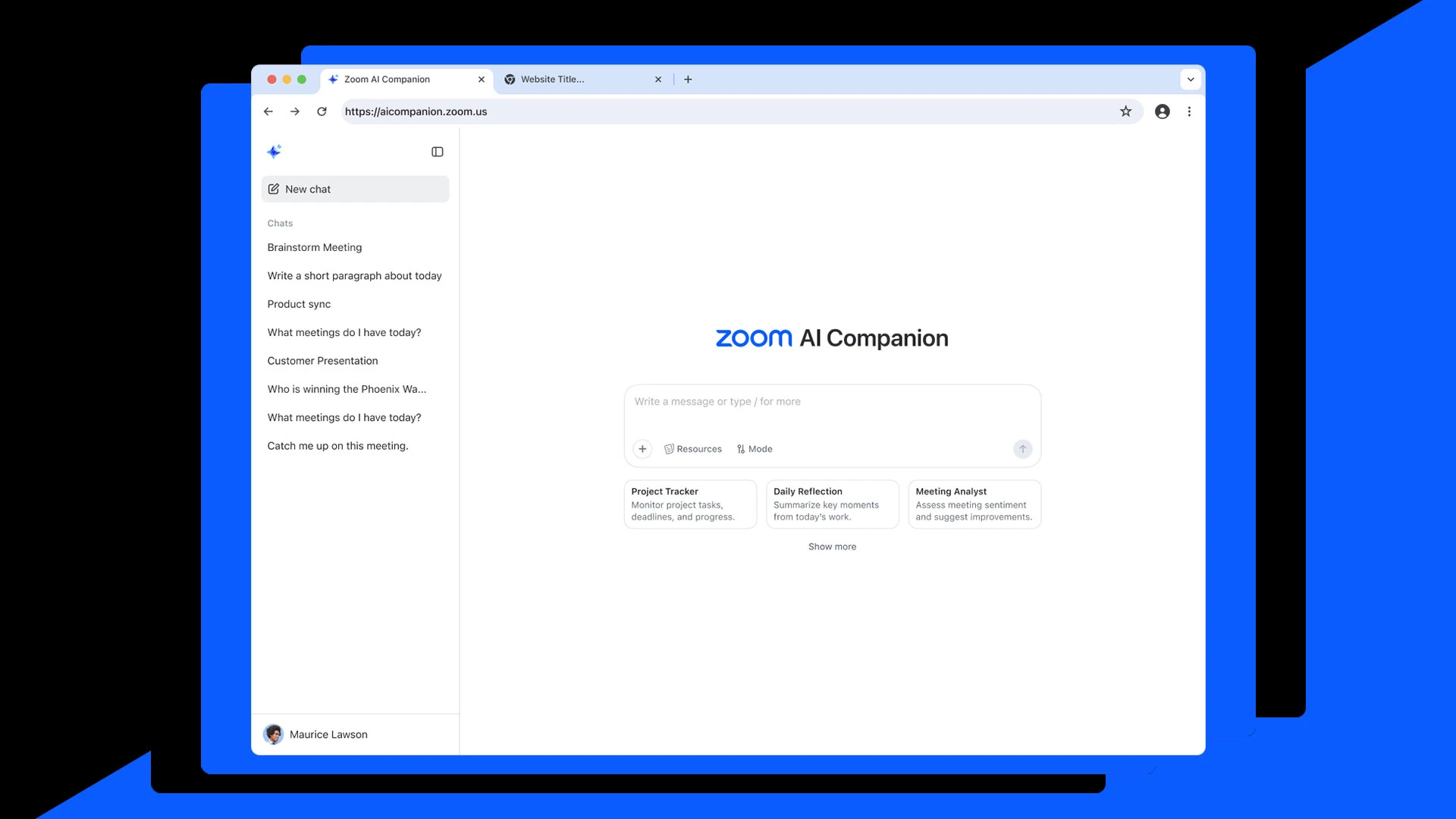
The phrase “Let’s hop on a Zoom call” has become part of everyday language, shorthand for virtual meetings that defined an era, from remote classrooms to boardrooms. Zoom rose to household-name status by keeping the world connected during the pandemic, but being synonymous with meetings has always been both a triumph and a trap. For years, the company has worked to shake the perception that it begins and ends in the virtual conference room.
At Zoomtopia 2025, its annual flagship conference, the company made its boldest move yet to redefine that identity. It announced the launch of AI Companion 3.0, a major upgrade aimed at positioning Zoom as a full-scale agentic AI workplace.
Instead of merely summarizing discussions, AI Companion can interpret intent, decide on next steps, and execute them across a wide array of applications and workflows, all powered by an agentic AI architecture. Zoom describes the shift as a move away from passive assistants toward true collaborators—systems designed not just to respond to requests but to anticipate needs, make decisions, and carry out tasks, much like a colleague would.
Xuedong Huang, Zoom’s chief technology officer, tells Fast Company that the latest upgrade moves beyond simple assistance by giving AI the ability to reason, remember, and take action. “The leap from a passive assistant to a proactive agent in AI Companion 3.0 is made possible through the integration of agentic skills, including reasoning, memory, task action, and orchestration,” he says. Under the hood, Zoom relies on a federated system that can pull from its own models as well as those from OpenAI and Anthropic, ensuring conversations reach resolution.
Zoom describes AI Companion 3.0 as a horizontal intelligence layer, capable of connecting to third-party apps so users can rely on “one single source of truth” across the applications they already use. The system can even extend into rival ecosystems such as Microsoft Teams, Google Meet, and WebEx.
Smita Hashim, Zoom’s chief product officer, says the goal is to change collaboration norms by allowing users to stay aligned and be more present in meetings without the distraction of manual note-taking. “AI Companion 3.0 is directly addressing the fragmentation plaguing hybrid teams that use multiple platforms to meet and collaborate, as well as small-business owners and solopreneurs who attend meetings on other platforms,” she says.
The emphasis on interoperability is a strategic choice. Enterprises are increasingly wary of vendor lock-in, especially when it comes to AI. Microsoft often ties Copilot closely to Office 365, and Google keeps its AI inside Workspace. Zoom, meanwhile, is attempting to carve out a distinct identity in a crowded field of workplace assistants.
Huang believes AI should work wherever employees already are, not force them to change where or how they work.
“Making our system platform-agnostic required developing the capability for AI Companion to work across Zoom Workplace and leveraging Agent2Agent capabilities with Custom AI Companion,” Huang says. “Building these features demands that we take a customer-centric approach to deliver both AI quality and ease of use simultaneously.”
Integrating Agentic AI Into Workflows
Zoom says AI Companion 3.0 can analyze a user’s calendar and suggest which meetings might be skipped, while still delivering AI-generated notes from the host. It can scan schedules across time zones and holidays to propose collaboration windows, taking over tedious coordination tasks that often slow teams down.
In addition, the platform’s new “free up my time” feature recommends meetings to skip based on daily tasks and past attendance patterns. Another new skill, enhanced meeting preparation, offers proactive prompts ahead of a meeting so participants arrive with the agenda and previous action items in hand.
“Harnessing the power of agentic AI is about bringing happiness back to work for the people,” Huang says. “It’s about freeing people from the mundane work we have to do and giving people more time to work on what really matters.”
Hashim says the company is expanding translation tools to make cross-border teamwork smoother and more inclusive. “We are also availing live translations for meetings to help users collaborate more easily with global colleagues and partners with fewer language barriers,” she says, pointing to an independent study showing Zoom’s captions outperformed those of rivals, with significantly higher accuracy in both French and Spanish.
advertisement
For organizations seeking agentic AI tailored to their business, Zoom is rolling out Custom AI Companion. This low-code builder lets administrators design and deploy custom AI agents, supported by a tooling library and prebuilt templates for common workflows.
According to Hashim, the goal is to make it simple for organizations to design and roll out their own AI agents with minimal friction. “The custom agent builder empowers IT admins to configure knowledge bases and tools and test their AI agents’ capabilities before deployment,” she explains. Zoom plans to provide starter templates so teams can quickly customize agents, which employees can then access directly within their existing workflows.
Zoom is also embedding its AI deeper into customer support, sales, and collaboration through its Customer Experience (CX) and Zoom Virtual Agent (ZVA) suite. According to the company, the tools can detect patterns in customer interactions, flag issues before they escalate, prioritize sales leads, and recommend next best actions. They can even act as group assistants, answering project questions, providing status updates in natural conversation, or controlling smart meeting rooms by voice.
While Microsoft and Google often reserve their AI features for premium tiers, Zoom is bundling AI Companion at no additional cost with paid Zoom Workplace accounts. Competing offerings can cost as much as $30 per user per month, making Zoom’s approach a direct challenge to competitors and a potential accelerator for adoption.
But openness carries risk. Interoperability appeals to CIOs, but it leaves Zoom dependent on access to competitors’ ecosystems. If Microsoft or Google were to tighten permissions, Zoom’s openness could quickly shift from an advantage to a liability.
Gartner analyst Adam Preset notes that major tech providers often create barriers to outside integrations, but that large organizations and regulators can push them toward more openness. “Big vendors can, and do, restrict APIs or change terms to limit third-party integration, making true interoperability a challenge,” he says.
In that environment, Zoom’s stance on open standards could help it stand out as a defender of customer choice.
What’s Next for Zoom?
Embedding agentic AI directly into the flow of workplace dialogue gives Zoom a natural path for adoption. But whether it can deliver industry-specific depth to match rivals who have spent years refining their platforms is another question.
Preset warns that companies shouldn’t commit to a single vendor too quickly. “The pace of change in workplace technology means enterprises need to stay flexible and avoid locking themselves into one path,” he says. Zoom’s free AI tools may spark adoption, but lasting trust will require deeper enterprise-grade capabilities.
Alongside its product announcements, Zoom also revealed a $10 million, three-year commitment to expand access to AI education and opportunity. That includes $5 million for K through 12 AI literacy, with large anchor grants to global organizations and smaller regional grants to local changemakers. First-round recipients include Code.org and Data.org, which help equip students, workers, and nonprofits with AI skills.
Huang says Zoom will keep refining its AI by blending its own models with those from partners and by strengthening integrations with widely used workplace apps. “Our ultimate goal,” he says, “is to leverage AI to transform every interaction into an opportunity for increased productivity, better outcomes, and stronger relationships.”



